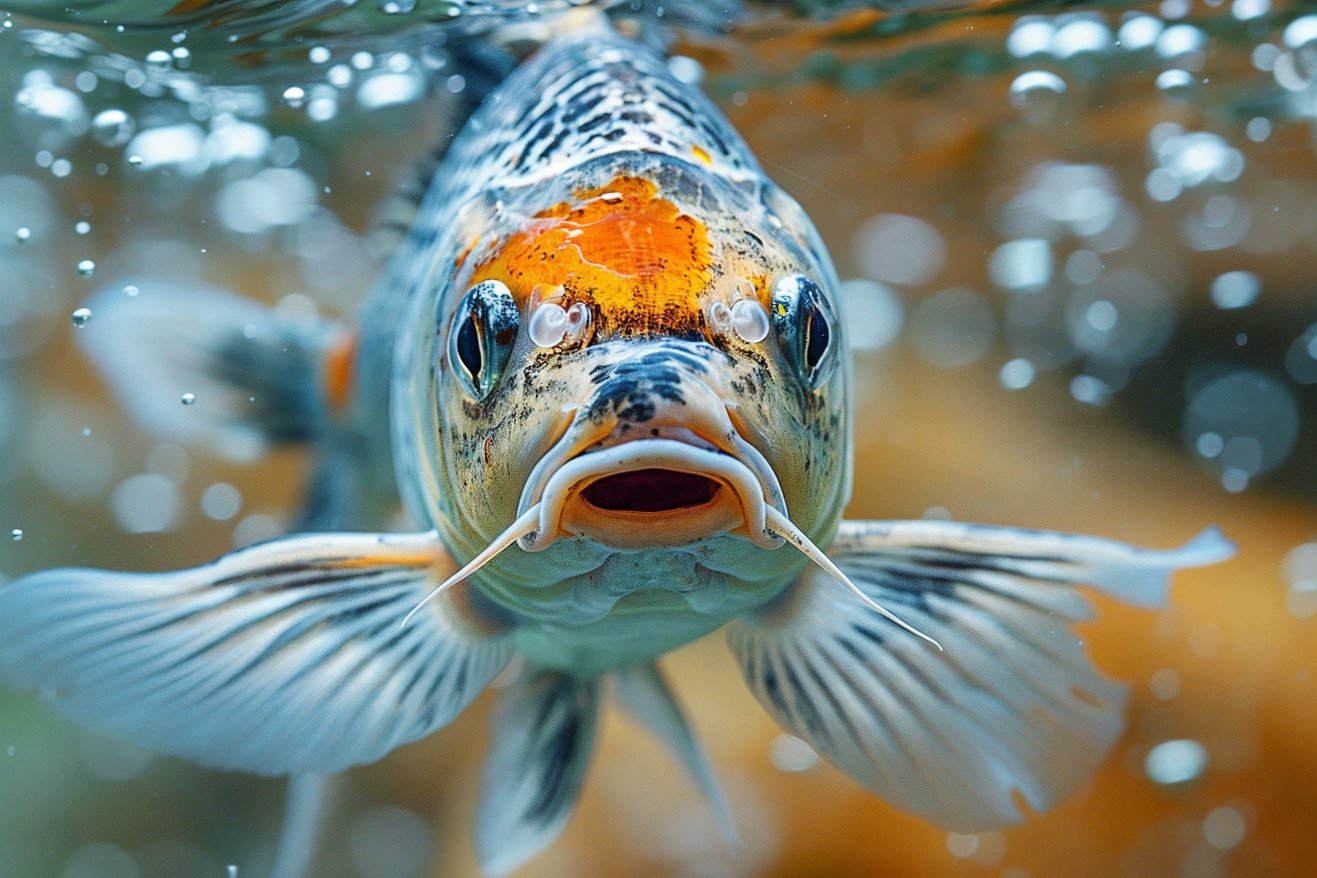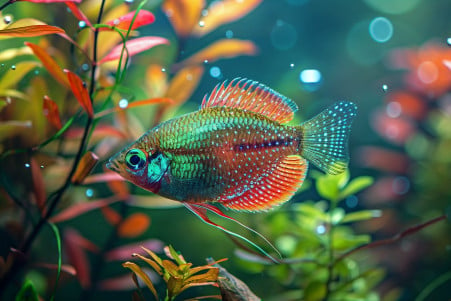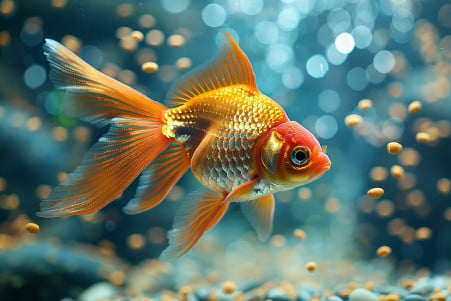What Do Koi Fish Eat? Understanding Their Diverse Dietary Needs
11 April 2024 • Updated 11 April 2024

Koi fish are omnivorous pond dwellers that need a mix of plant material, insects, and specialized koi feeds to maintain their bright colors and strong immune systems. Good koi foods include high-quality pellets or flakes that are made with fishmeal, algae, vegetables, and vitamins, as well as fresh produce like lettuce or cucumber for stimulation.
By looking at the diverse dietary needs of koi fish, we will cover information from aquaculture, koi breeding, and nutrition to give a well-rounded view of the best way to feed these special ornamental fish so that they live long, healthy lives and maintain their beautiful looks.
What do koi fish eat?
What Do Koi Fish Eat? The Complete Nutritional Guide
The koi fish diet is a complex mix of proteins, vitamins, minerals, fats, and carbohydrates that are necessary for koi to be healthy and grow. Since koi are omnivorous, they need a diverse diet to get all of the nutrients they need.
The majority of a koi's diet should be made up of commercial koi food pellets or flakes, which are designed specifically to provide all of the nutrients that koi need. These foods are made with ingredients like fishmeal, algae, vegetables, and vitamins.
The number of times you feed your koi each day will depend on the water temperature, the size of your fish, and whether you have a regular or ecosystem pond. Iowa Waterscapes recommends that in the summer when the water temperature is between 64-88°F, large adult koi should be fed 2-4 times a day for 3-5 minutes at a time to avoid overfeeding. In the spring and fall when the water temperature is between 50-64°F, feed your koi once or twice a day.
When the water temperature drops below 50°F, koi's metabolism slows down. At this point, you should feed them a wheat germ-based food that's easier to digest or stop feeding them altogether until the spring when the water temperature rises above 50°F. Adjusting your koi's diet to the seasons will help ensure that they stay healthy throughout the year.
While commercial foods are nutritionally complete, you can also feed your koi treats to provide them with mental stimulation and a more varied diet.
Supplementing With Safe Treats: Fruits, Vegetables, and Live Foods
In addition to commercial koi food, koi can be given treats to help keep their diet interesting and varied. Groundskeeper Inc. lists several safe treats, including fresh fruits such as watermelon, bananas, and citrus fruits, and vegetables such as lettuce and cucumber. Protein-rich live foods like brine shrimp, silkworm pupae, and earthworms can also be given as supplements.
On the other hand, koi owners should avoid feeding their fish hard-to-digest treats like bread, corn, beans, and processed snacks, as these can lead to digestive issues. Pond Armor warns that white bread is made with bleached flour that can be problematic for koi. In general, treats should be fed in moderation and never be used to replace the staple koi food diet.
By feeding koi a combination of high-quality commercial food and safe treats, koi owners can make sure their fish get the nutrients they need while also keeping their diet interesting and varied. However, it's important to be aware of toxic plants and other foods that can be harmful to koi and should be avoided at all costs.
Plants and Other Foods That Are Toxic to Koi Fish
There are a number of plants and plant parts that can be toxic to koi fish, and pond owners should make sure to keep them away from their ponds. According to Koiphen.com, some of the most common garden plants that can be toxic to koi include azaleas, daffodils, oleander, and rhododendrons. Meanwhile, The Water Gardener's Bible notes that leaves from trees like oak, willow, and poplar can also be toxic and should be removed from ponds.
In addition to the plants that can be toxic to koi, there are a number of other foods that can be toxic to koi, including processed foods, bread, and wild-caught fish. Funkykoi.com notes that it's important to keep a clean, plant-free pond to avoid accidental poisoning of koi fish.
Pond owners who are aware of the plants, leaves, and other foods that can be toxic to koi fish can make sure to keep them away from their ponds and ensure their fish are healthy and safe. It's also important to make sure to adjust feeding schedules and pond maintenance to prepare for the winter months.
Winter Care: Changing Feeding Habits and Keeping the Pond Healthy
When water temperatures fall below 50°F, koi go dormant and their digestive systems shut down, so they should not be fed. Aquanooga notes that once the water temperature drops below 50 degrees, feeding should be stopped completely until spring when the water temperature is consistently above 50°F.
That said, in the 50-64°F range, koi can be fed a wheat germ-based cold water food once or twice a day or every other day. Alabama Aquarium & Pond Services explains that as the water temperature drops from 50 degrees to 41 degrees F, you should only feed your koi two to three times a week.
It’s important to make sure that gas exchange can happen during the winter. Aquanooga suggests using an aerator or floating pond de-icer to keep at least a small part of the pond ice-free. This will allow toxic gases that build up from decomposing organics to escape and oxygen to enter the water.
Keeping the pond environment healthy is also important. Aquanooga explains that you should remove dead foliage from pond plants and switch to a cold water bacteria in the fall. This will help make sure that the ecosystem is as active as possible during the winter.
By making sure that feeding is adjusted and that the pond is in the best possible condition, koi owners can make sure that their fish make it through the winter and come out healthy and happy in the spring.
Feeding Techniques and Schedules for Optimal Koi Health
Consistency is key when it comes to feeding schedules, as koi are creatures of habit. Kodama Koi Garden notes that koi breeders in Japan use automatic feeders to make sure their koi are fed several times a day with the same high-quality food, even if the owner can't be there to feed them. This way, the fish are always fed at the same time, which they will come to expect.
It is suggested that koi owners follow the "5-10 minute feeding rule," which means that you should only feed your koi the amount of food that they can eat in this time period. Next Day Koi recommends feeding a small amount of food, waiting for the fish to eat it, and then feeding a little more, repeating this process for 5 minutes before stopping. Any food that the fish don't eat should be removed immediately to avoid water quality problems and potential health issues.
Feeding schedules and amounts should be changed based on the season and water temperature to make sure that the fish can digest their food properly. Blue Ridge Koi & Goldfish explains that koi should be fed more often in the spring and summer when the water is warmer and their metabolism is higher and less often (or not at all) in the winter when the water is colder.
By sticking to these best practices for consistent feeding schedules, portion sizes, and seasonal changes, koi owners can make sure that their fish are getting the nutrition that they need to be healthy and show off their beautiful colors.
Conclusion: How to Feed Koi a Diverse and Balanced Diet
To keep koi fish healthy, colorful, and happy, it's important to feed them a diverse and balanced diet. While commercial koi food is the mainstay of their diet, it's also important to supplement their meals with fresh fruits and vegetables. Feeding schedules and portion sizes should be adjusted based on water temperature, koi size, and pond ecosystem.
It's also important to avoid toxic plants, processed foods, and overfeeding to keep koi fish healthy and maintain a clean pond. By following proper feeding guidelines and providing a varied and nutritious diet, koi owners can ensure their fish thrive and show off their beautiful colors.


